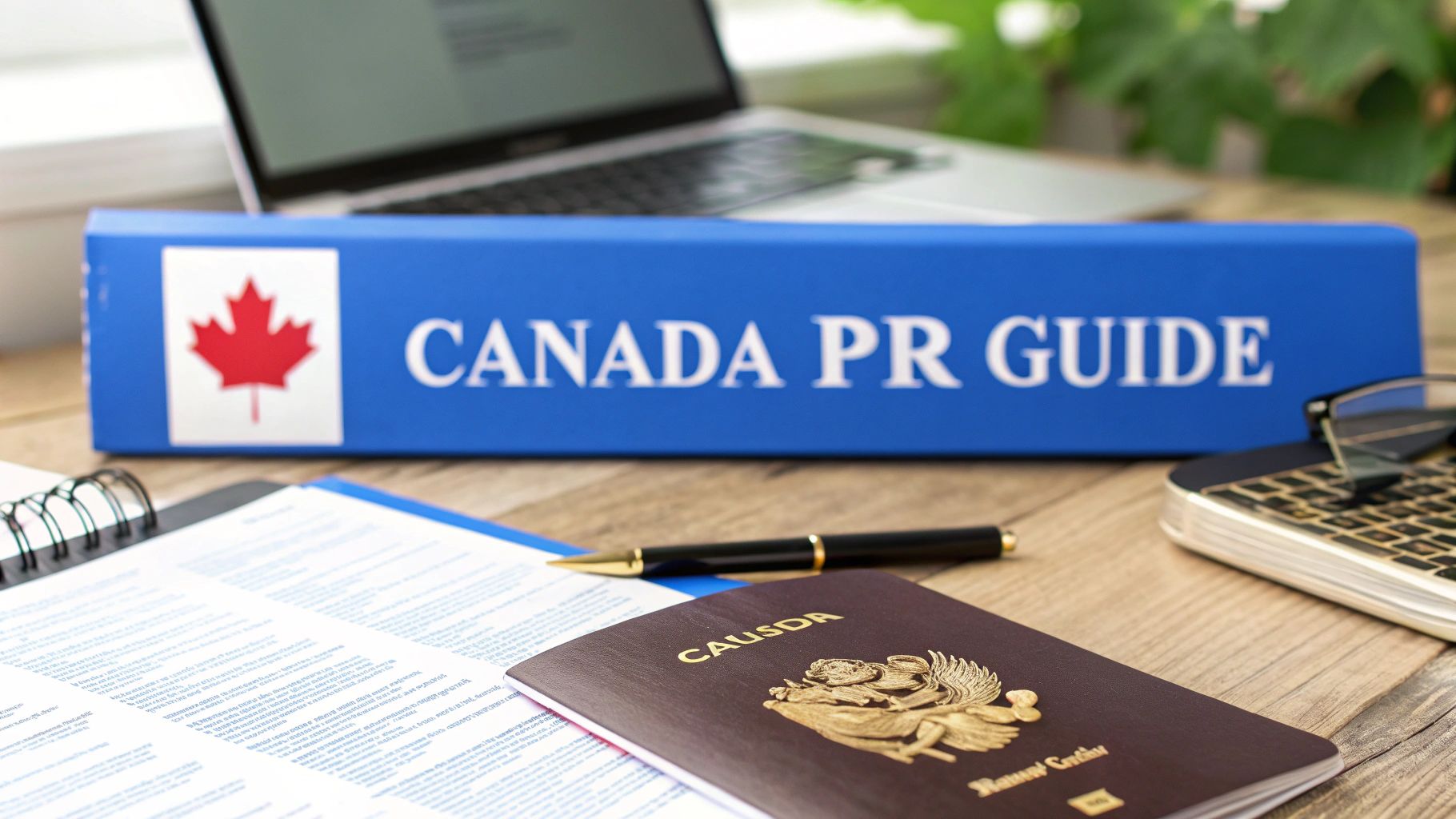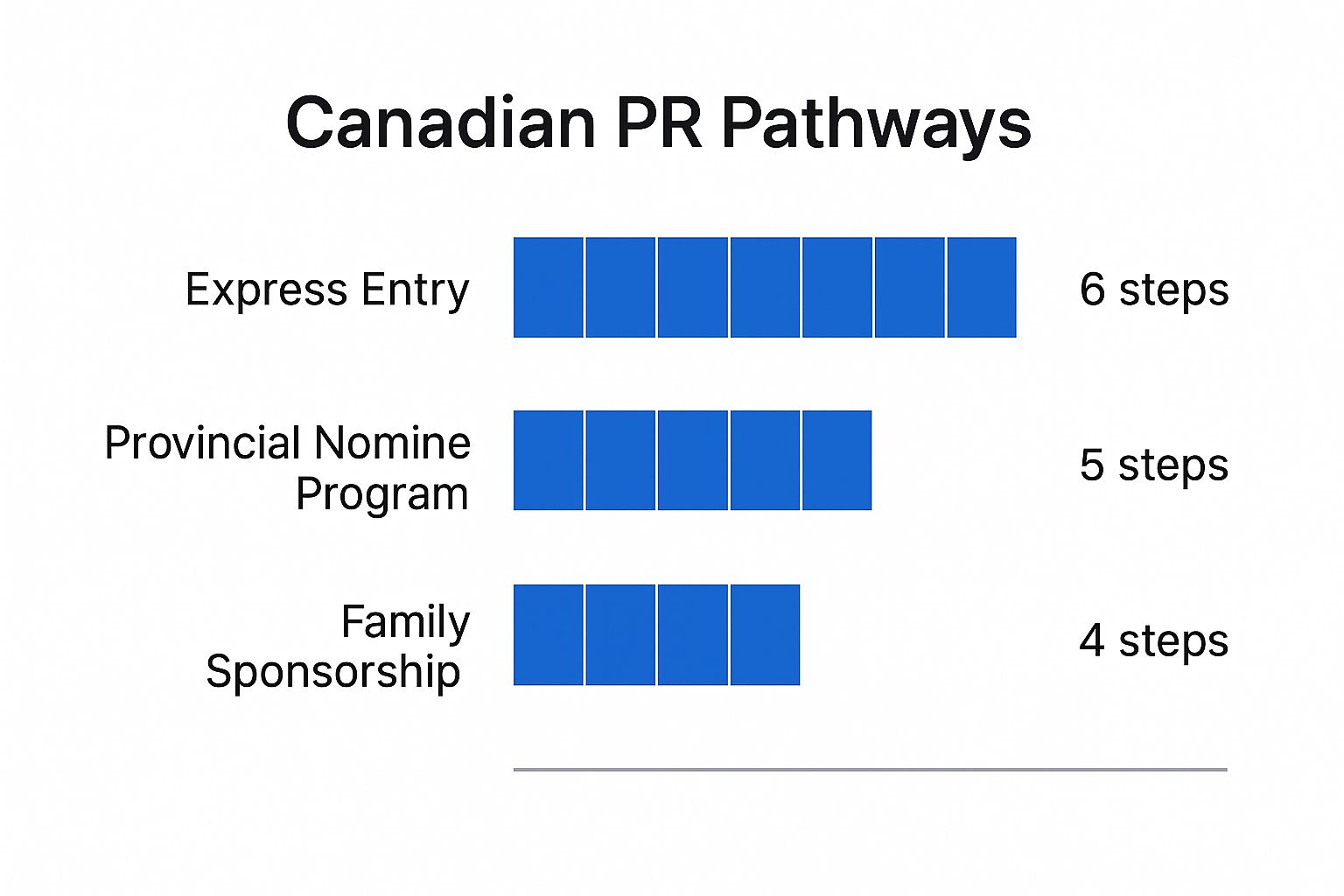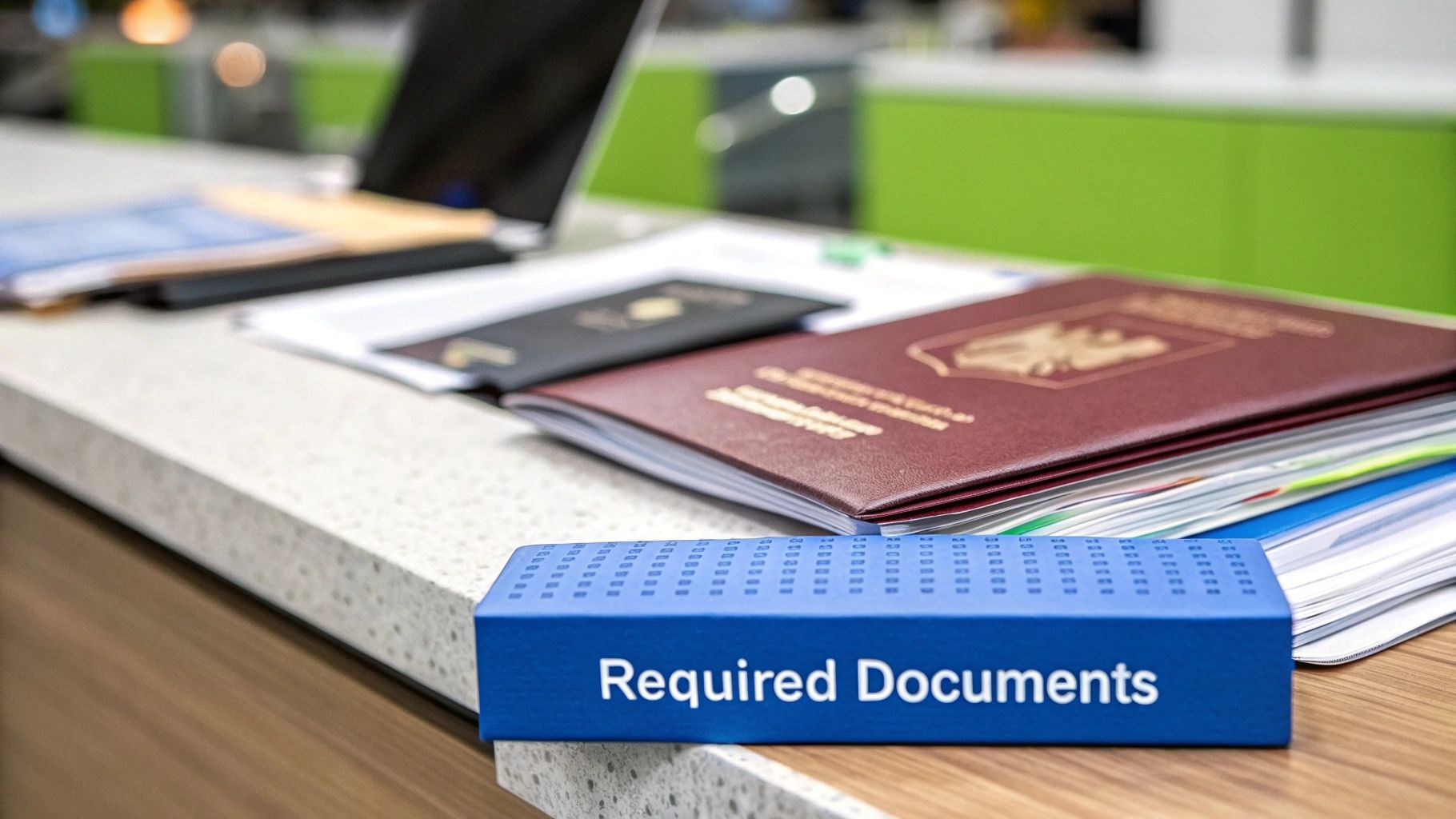Permanent Residency Application Canada: Your Complete Guide

Your journey to permanent residency in Canada isn't a single path, but a network of trails. Most people get there through economic programs like Express Entry or the various Provincial Nominee Programs (PNPs). Figuring out which of these is your best bet from day one is the secret to putting together a winning application.
Decoding Canadian Permanent Residency Pathways

Embarking on the process to become a permanent resident can feel overwhelming. Let’s break it down. At its heart, Canadian permanent residency (PR) gives you the right to live, work, and study anywhere in the country for good. It's the most stable, long-term status you can get before becoming a full citizen, and it unlocks major social benefits like healthcare coverage.
The Canadian government has created several immigration streams, each one tailored for a different kind of applicant. Your personal situation—your age, what you've studied, your work history, and your English or French skills—is what will ultimately point you to the right pathway.
Understanding the Main Immigration Streams
The most well-trodden paths for skilled professionals fit into a few main categories. If you get a handle on what each one is for, you can build a much smarter application strategy.
-
Express Entry: Think of this less as a program and more as a sophisticated online system. It’s how the government manages applications for three key economic programs: the Federal Skilled Worker Program, the Canadian Experience Class, and the Federal Skilled Trades Program. You create a profile, and you're ranked against every other candidate in the pool using a detailed points system.
-
Provincial Nominee Programs (PNPs): Almost every Canadian province and territory has its own unique immigration programs. They use these to find and invite workers who have the specific skills their local economies desperately need. Getting a provincial nomination is a huge advantage—it can add a massive number of points to your Express Entry profile or even let you apply for PR directly with the province.
-
Family Sponsorship: If you have a close family member who's already a Canadian citizen or permanent resident, this might be your route. This stream is designed for spouses, common-law partners, dependent children, parents, and grandparents.
Key Takeaway: The single most critical decision you'll make is choosing the right immigration program. Your success hinges entirely on matching your personal profile to the precise requirements of a program, whether that's through Express Entry or a specific PNP.
It's also crucial to remember that the Canadian immigration landscape is constantly changing, driven by government priorities and economic demands. Policy shifts can suddenly make the whole process much more competitive.
For example, in 2025, Canada adjusted its target to welcome 395,000 new permanent residents, a noticeable drop from previous years. This single change had a ripple effect, causing an 11% decrease in Invitations to Apply (ITAs) during the first half of the year. Consequently, the average Comprehensive Ranking System (CRS) score needed to get an invitation shot up from 481 to a staggering 617.
For applicants from Nigeria, this means the competition is fiercer than ever. You can learn more about how these changes impact the express entry system and what it means for your application. Keeping a close eye on these trends is absolutely essential for planning your next move.
Finding Your Best Immigration Program
Your journey to Canadian permanent residency starts with one critical step: figuring out which immigration program is the right fit for you. This isn't just about ticking boxes to meet minimum requirements; it’s about strategically choosing the path where your unique profile—your age, education, work history, and language skills—gives you the best possible chance of success.
Think of it this way: your personal and professional background are your key ingredients. The various immigration programs are the recipes. You need to find the recipe that makes the most of what you have.
This chart gives you a bird's-eye view of the stages involved in the most common PR pathways.

While Family Sponsorship looks simpler, the reality for most skilled professionals from Nigeria is that economic routes like Express Entry and the Provincial Nominee Programs (PNPs) are the most accessible.
The Express Entry System and Its Programs
For economic immigration, Express Entry is the main game in town. It’s essentially a system that manages a pool of skilled candidates for three key federal programs. Your primary goal is to get the highest score possible on the Comprehensive Ranking System (CRS), which is what determines your rank against everyone else in the pool.
The CRS awards points based on:
- Core Human Capital: This covers your age, education level, English or French language skills, and any Canadian work experience you have.
- Spouse or Partner Factors: If you're applying with a spouse, their education, language abilities, and Canadian work experience can also add valuable points.
- Skill Transferability: This is where things get interesting. The system rewards powerful combinations, like having strong language skills and post-secondary education, or foreign work experience paired with high language proficiency.
- Additional Points: These are the real game-changers. A massive point boost comes from a provincial nomination (600 points), a valid job offer, or a Canadian educational credential.
The secret to a high CRS score often lies in the combination of your skills. I've seen countless cases where someone with top-tier language scores (CLB 9 or higher) combined with a master's degree leapfrogs others in the pool. It’s not just about one strong area; it’s about how your strengths work together.
Once you have a rough idea of your potential points, you can see which of the three main Express Entry programs fits you best.
To help you see the differences at a glance, here’s a quick comparison of the three main Express Entry streams.
Comparing the Main Express Entry Programs
This table breaks down the core requirements for the Federal Skilled Worker Program, Canadian Experience Class, and Federal Skilled Trades Program. It's a great way to quickly identify which stream aligns with your background.
| Feature | Federal Skilled Worker (FSWP) | Canadian Experience Class (CEC) | Federal Skilled Trades (FSTP) |
|---|---|---|---|
| Primary Target | Skilled workers with foreign experience | Individuals with recent skilled Canadian work experience | Qualified tradespersons in specific occupations |
| Work Experience | 1 year continuous skilled work (foreign) in the last 10 years | 1 year skilled work in Canada in the last 3 years | 2 years full-time work in a skilled trade in the last 5 years |
| Language Minimum | CLB 7 in all four abilities (English/French) | CLB 7 for TEER 0, 1 jobs; CLB 5 for TEER 2, 3 jobs | CLB 5 for speaking/listening; CLB 4 for reading/writing |
| Education | Secondary education required; points awarded for post-secondary | No minimum education requirement | No minimum education requirement |
| Job Offer | Not required, but adds significant CRS points | Not required | Required, or a certificate of qualification from a Canadian province |
Choosing the right program is the foundation of your application. As you can see, someone with extensive foreign experience would target the FSWP, while a graduate who has worked in Canada for a year is a perfect fit for the CEC.
Ready to get started? We have a detailed guide that walks you through creating an Express Entry profile and navigating those crucial first steps.
Exploring Provincial Nominee Programs
What if your CRS score isn't quite high enough to get an invitation directly through Express Entry? Don't lose hope. This is where the Provincial Nominee Programs (PNPs) come in, and for many people, they are an even better route.
Every province and territory (except Quebec, which runs its own system) has its own PNPs designed to attract newcomers who meet their specific labour market needs. For example, British Columbia might be desperate for tech workers, while Nova Scotia is actively recruiting nurses and Saskatchewan needs truck drivers.
PNPs generally fall into two categories:
- Enhanced Streams: These are linked directly to the Express Entry system. A province might search the pool and send a "notification of interest" to candidates who fit their criteria. If you accept and receive the nomination, you get an extra 600 CRS points. That’s a massive boost that practically guarantees you’ll get an Invitation to Apply (ITA) for permanent residency.
- Base Streams: These operate completely outside of Express Entry. You apply straight to the province. If they approve you, they give you a nomination certificate, which you then use to submit a separate paper-based or online permanent residency application to the federal government.
The key here is research. Instead of just waiting in the massive Express Entry pool, you can be proactive and find a province that is actively looking for someone with your exact skills. If you're a healthcare professional, for instance, targeting provinces with dedicated healthcare streams can be a much more effective strategy.
Preparing Your Documents Without Mistakes

Your journey to Canadian permanent residency really comes down to the quality of your paperwork. Think of it less like a chore and more like building a legal case for yourself. One small error—a missing signature, a document that’s expired, or a badly written reference letter—can cause frustrating delays or, worse, get your application flat-out rejected by Immigration, Refugees and Citizenship Canada (IRCC).
This isn't just about collecting a stack of papers. It’s about getting every single detail right from the very beginning. Let’s walk through the essential documents and how to prepare them perfectly.
The Foundation: Your Language and Education Credentials
Before you can even think about the rest of your application, you need to sort out your language test results and your Educational Credential Assessment (ECA). These are the absolute cornerstones of any economic immigration stream; you can’t even get into the Express Entry pool without them.
Language Tests (IELTS or CELPIP)
The scores you get on your language test are your proof of English or French proficiency, and they have a massive impact on your Comprehensive Ranking System (CRS) score. Even a slight improvement in your score can give your profile a significant boost.
- Book Well in Advance: Test dates for IELTS and CELPIP can fill up incredibly fast, especially in major Nigerian cities. I always advise clients to book their test at least two to three months before they want to create their Express Entry profile.
- Aim for the Top Tier: Your goal should be a Canadian Language Benchmark (CLB) level of 9 or higher in all four abilities (reading, writing, listening, and speaking). This is the sweet spot that unlocks the maximum points for skill transferability.
Educational Credential Assessment (ECA)
An ECA is simply a report from a designated organisation that confirms your foreign degree, diploma, or certificate is valid and equivalent to a Canadian one. You must have this report in hand before you can submit your profile.
I once worked with an applicant who was certain his three-year degree from a top university in Lagos would be counted as a Canadian bachelor's degree. The ECA report came back equating it to a two-year diploma, which torpedoed his CRS score. Don't make assumptions—get the assessment done early to see exactly where you stand.
Gathering Your Proof of Work and Identity
With your core credentials sorted, it's time to gather the documents that prove who you are and what you've done professionally. This is where so many applicants stumble over easily avoidable mistakes.
Work Experience Reference Letters
This is probably the single most scrutinised document in your entire application. IRCC has very specific rules for what these letters must include, and a generic one from your HR department simply won't cut it.
For a reference letter to be accepted, it absolutely must:
- Be on official company letterhead.
- List the company’s full contact information (address, phone number, and email).
- Be signed by your direct supervisor or an HR manager.
- Clearly state your exact employment dates, your job title, your main duties, your annual salary plus any benefits, and how many hours you worked each week.
The most common error I see is a failure to list job duties that align with the lead statement of the chosen National Occupational Classification (NOC) code. Your letter has to prove you actually performed the work of that specific occupation. For a deeper look at how all these pieces fit together, you can explore the complete guide on the Canada permanent residence application.
Police Certificates and Other Key Documents
Finally, you’ll need to collect police certificates and a few other key documents. These are required to prove that you are admissible to Canada.
Police Certificates
You will need a police clearance certificate from every single country or territory where you have lived for six or more months consecutively since you turned 18. The process for obtaining these can vary wildly from one country to the next, so start this process as early as possible. Some can take months to arrive.
Proof of Funds
You must demonstrate that you have enough money to support yourself and your family when you land in Canada. The required amount is updated annually, so always double-check the latest figures on the official IRCC website. Crucially, these funds must be readily available to you, not tied up in property or burdened by debt.
To keep everything straight, using effective knowledge retention strategies is a lifesaver. Something as simple as a personal checklist where you track the status of each document can prevent a critical piece of evidence from being forgotten.
Submitting Your Application and Managing the Wait

Hitting that "submit" button on your permanent residency application feels monumental. After months of gathering documents, studying for language tests, and poring over every detail on the forms, it's a huge moment of relief and excitement. But this isn't the finish line—it's the start of the next phase: the waiting game. Knowing what comes next is crucial for managing your expectations and staying on top of your application.
Once you receive that coveted Invitation to Apply (ITA), a new clock starts ticking. You have a strict 60-day window to submit your complete application through the official IRCC portal. This is your cue to review everything one last time, not to start from scratch. Your job now is to double-check that every document is correct, pay the fees, and upload your files perfectly.
Pro Tip: Don’t push it to the deadline. I’ve seen too many people run into last-minute technical glitches or realise a crucial document has just expired. Aim to submit your application at least a week or two early. That buffer can be a lifesaver.
Navigating the Post-Submission Stages
After you've successfully submitted everything and paid your fees, your application enters a fairly predictable sequence of stages. Understanding this flow can really help dial down the anxiety of the long wait.
The first thing you’ll get is the Acknowledgment of Receipt (AOR). This email confirms IRCC has your application and is your official signal that processing has started. Your AOR will also contain your unique application number, which is your key to tracking your status online.
From there, your application goes through several important checks. Here's a rundown of what to expect:
- Biometrics Request: If you're applying from Nigeria, you'll almost certainly need to provide your fingerprints and a photo. You'll receive a Biometric Instruction Letter (BIL) and have 30 days to get this done at a designated Visa Application Centre (VAC).
- Medical Exam: IRCC will require you to complete an immigration medical exam (IME) with one of their approved panel physicians. You can either do this upfront before you even apply or wait for IRCC to send a request.
- Background Checks: This is a standard part of every application. IRCC will conduct thorough security and criminality checks to make sure you are admissible to Canada.
It’s absolutely vital to keep a close eye on your email and your IRCC account during this time. If an officer needs more information or an updated document, they'll contact you through the portal with a strict deadline. Missing one of these requests is one of the fastest ways to get your application refused.
Managing the Wait and Checking Your Status
The wait for a final decision is often the toughest part of the entire journey. Processing times can be all over the map, depending on your immigration program, your country of residence, and the sheer volume of applications IRCC is dealing with at any given time.
For context, Canada’s immigration system is currently handling a massive number of applications. Just between January and May 2025, IRCC processed roughly 227,800 study permits and 591,200 work permits. Many of these are pathways to permanent residency, and these numbers show the incredible demand that can affect wait times for PR applicants from Nigeria and around the world. You can get a better sense of this by reading about how IRCC is handling application inventories on their official site.
You can track your application's progress through your secure IRCC online account. The portal shows you updates as you move through the stages. For a more detailed look, some applicants order GCMS (Global Case Management System) notes, which offer a deeper dive into how their file is being processed.
Finally, you’ll get a "Portal 1" email—often called the "golden email"—asking you to confirm your details. This is followed by a "Portal 2" email with credentials to a new portal where you'll declare you’re in Canada and upload a photo for your first PR card. This last step leads to your electronic Confirmation of Permanent Residence (eCoPR), the document that officially makes you a Canadian permanent resident.
For many people dreaming of making Canada their permanent home, the path isn't always a direct flight. In fact, one of the most successful strategies I've seen over the years is a two-step approach: start with temporary status as a student or foreign worker, and then make the leap to permanent residency.
This isn't just about biding your time; it's a calculated move. Building a foundation in Canada first—by working or studying here—is incredibly valuable in the eyes of the immigration system. It shows you can integrate, contribute, and thrive, which can seriously boost your chances of getting that coveted PR card.
The Power of Canadian Work Experience
So, what's the big deal with working in Canada first? It unlocks the Canadian Experience Class (CEC), an Express Entry stream designed specifically for people who have at least one year of skilled Canadian work experience. For many, the CRS score needed for the CEC is often more achievable than for the Federal Skilled Worker Program (FSWP), which primarily assesses foreign experience.
Let me paint a picture for you. I often work with IT professionals from Nigeria who have fantastic overseas experience. Their CRS score might be good, but it's just shy of the FSWP cut-off. The game-changer is when they land a job offer and come over on a work permit. After just one year on the job here, they suddenly qualify for the CEC. That single year of Canadian experience adds a massive chunk of points to their score, often pushing them well over the invitation threshold.
This isn't just a loophole; it's a well-trodden and highly effective strategy. It transforms your profile from that of a foreign applicant to someone who has already proven they can succeed in the Canadian labour market. On top of that, this experience makes you a prime candidate for many Provincial Nominee Programs (PNPs), especially if you're already working in an in-demand field within that province.
If there's one piece of advice I find myself giving over and over, it's this: getting even one year of Canadian work experience can completely rewrite your immigration story. It's often the single factor that moves an application from 'almost there' to 'approved.'
From Student to Permanent Resident
Starting out as an international student is another brilliant pathway. When you complete a programme at a Designated Learning Institution (DLI), you don't just walk away with a Canadian qualification. You often become eligible for a Post-Graduation Work Permit (PGWP).
Think of the PGWP as your golden ticket. It's an open work permit, which means you're free to work for nearly any employer in Canada. This freedom is exactly what you need to clock the one year of skilled work experience required for the CEC.
Here’s the typical game plan:
- Study: You complete a degree or diploma programme that’s at least eight months long.
- Get a PGWP: After graduating, you apply for a PGWP. Its length (up to three years) usually depends on how long your study programme was.
- Work: You find a skilled job—that’s anything in TEER 0, 1, 2, or 3—and work full-time for at least one year.
- Apply for PR: Armed with your Canadian education and work experience, your CRS score is now much stronger, making you a top-tier candidate in the Express Entry pool.
This "study-work-immigrate" model is genuinely one of the most reliable routes to permanent residency in Canada.
Understanding the Current Landscape
Now, it's crucial to know that the ground is shifting. Government policies around temporary residents are evolving, and the numbers tell an interesting story.
As of early 2025, Canada was home to about 2,959,825 non-permanent residents, which is 7.1% of the total population. But this number is actually down from previous counts, with the biggest drop seen among study permit holders. For prospective immigrants, including many from Nigeria who rely on these temporary permits, this trend is a signal. It suggests that the pathways from temporary to permanent status are becoming more carefully managed and, frankly, more competitive. You can read more about these recent demographic shifts to get a feel for the current climate.
What does this mean for you? It means having a crystal-clear strategy is more important than ever. Carefully choosing the right study programme or securing a solid job offer isn't just a preliminary step—it's the foundational move that will set up your entire permanent residency journey for success.
Common Questions About Your PR Application
As you get deeper into your permanent residency application, you're bound to have questions. It’s a complicated journey, and it’s completely normal to want to double-check the details. I've been helping people with this for years, and a few key questions always come up. Let's break them down so you can move forward with confidence.
How Do I Properly Show Proof of Funds?
Getting your proof of funds right is absolutely critical for most economic immigration routes, especially the Federal Skilled Worker Program. IRCC needs to be certain you have the money to support yourself and your family when you land in Canada.
The most important thing to remember is that these funds must be unencumbered and readily available. In plain English, this means the money can't be tied up in property, used as collateral for a loan, or be part of any borrowing arrangement. It needs to be liquid cash in an account under your name or your spouse's.
Here's a real-world scenario: let's say you've saved the required amount, but a big chunk of it was a recent gift from your parents. You can't just let that sit there unexplained. You’ll need a sworn affidavit or a formal gift deed from them to prove to the visa officer that it's a genuine gift, not a loan you have to pay back.
For a much deeper dive, our guide on preparing your proof of funds for Canada has specific examples and document checklists you'll find really helpful.
A mistake I see all too often is people trying to use funds from a business account. IRCC almost never accepts this. Business capital isn't considered your personal, accessible money. It must be in a personal chequing or savings account.
Can I Include My Family in My Application?
Yes, absolutely. In fact, you should include your immediate family members in your application from the very beginning. This ensures that if your application is approved, they get their permanent resident status at the same time you do.
Typically, your accompanying family members are:
- Your spouse or common-law partner.
- Your dependent children (usually under 22 years old and without a spouse or partner of their own).
- Your partner's dependent children.
- A dependent child of one of your dependent children (a grandchild).
It is vital that you declare every single family member, even if they have no plans to come to Canada with you right now. If you fail to declare a dependent, you may never be able to sponsor them in the future.
Think about it this way: if you have a child but decide to leave them off the application to save a bit on fees, you might permanently lose the right to bring that child to Canada later. Always declare everyone, even if you list them as "non-accompanying."
What Happens If My PR Application Is Rejected?
Getting a rejection letter is tough, but it doesn't automatically mean it's the end of your Canadian dream. The very first thing you need to do is sit down and carefully read the refusal letter from IRCC. It will tell you exactly why they turned down your application.
From there, you generally have a few ways to proceed:
- Re-apply: This is the most common path forward. If the refusal was because of a simple mistake you can fix—like a missing document or an incorrectly filled-out form—your best bet is to correct the issue and submit a new, much stronger application.
- Request Reconsideration: This isn't for submitting new information. You can only request this if you genuinely believe the officer made a factual or legal mistake when reviewing your existing file. You're asking them to look again because of their error.
- Appeal to the Federal Court: If you believe the decision was unreasonable, legally flawed, or unfair, you can apply for a judicial review. This is a serious legal step and one you'd almost certainly need an immigration lawyer for.
For instance, if your application was rejected because your employment reference letter didn't specify your weekly work hours, the fix is straightforward. Get a new, corrected letter from your employer and create a fresh Express Entry profile to get back in the pool.
What Are the Consequences of Misrepresentation?
This is the big one. Misrepresentation is one of the most serious offences you can commit in Canadian immigration. It means providing information that is untrue, misleading, or incomplete, either directly or indirectly. If that false information causes an officer to approve you when they otherwise wouldn't have, the consequences are severe.
If you're found guilty of misrepresentation, you could be looking at:
- A five-year ban from applying for any kind of status in Canada.
- A permanent record of fraud with IRCC that will follow you forever.
- Being removed from Canada if you’re already here.
And this isn't just about telling an outright lie. It can also be about "omission"—purposefully leaving out critical information. For example, not mentioning that you were once refused a visa to another country could be flagged as misrepresentation.
Takeaway: The golden rule here is simple: be completely, 100% honest and transparent about everything. If you're not sure how to answer something, it is always, always better to explain your situation truthfully than to hide it. The risk of being caught is simply not worth the devastating fallout.
Navigating the complexities of a permanent residency application for Canada from Nigeria requires accurate, up-to-date information. Don't leave your future to chance. JapaChat provides instant AI-powered guidance on everything from document checklists to program eligibility, all tailored to your unique situation. Start planning your journey with clarity and confidence today. Sign up for free at https://japachat.com.

Leave a Reply